Hi Everyone,
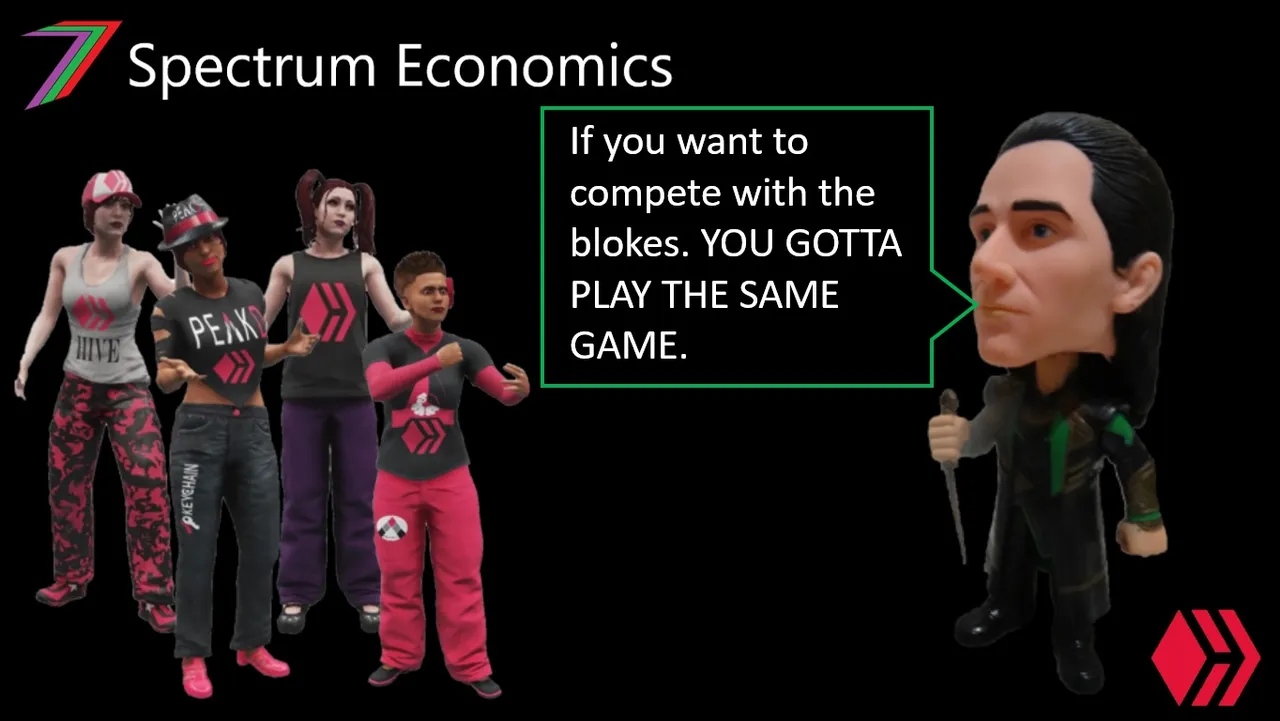
There is plenty of literature discussing sex and gender inequality. Much of the literature focuses on men and women in regards to opportunities, rights, and representation. Increased opportunities are often linked to more women in the workforce and higher educational attainment. Increased rights are often linked to voting, owning property, inheritance, and reproductive healthcare. Increased representation is often linked to more women in political office and Government. There are far fewer discussions relating to masculinity and femininity and any possible discrimination against masculine and feminine traits and roles. There is also limited discussion about the validity of different indicators and measures of inequality and the possible motives for their usage.
In this three part series, I want to discuss the subjugation of femininity and the distortion of reality in regards to the treatment of women and to a certain extent men.
- In Part 1, I discuss several important definitions and I investigate the main measures and indicators used to compare gender/sex equality in various countries.
- In Part 2, I discuss the natural differences between the sexes as well as the data and trends relating to wages, job opportunities, and places of employment.
- In Part 3, I discuss my opinions regarding inequality between men and women and how the Establishment created this problem just to pretend to be solving it.
Pertinent Definitions

Before we can investigate and interpret the data and statistics, we need to understand the relevant terminology. Terminology is particularly important to any discussions in regards sex and gender because of the changes in definitions, the inconsistent use of terminology and the introduction of new terminology. This section of the post will focus on the terminology I consider to be most relevant to this post. This terminology relates to sex, gender, gender identity, men, women, and feminism. I will be focusing on definitions provided by internationally recognised dictionaries such as the Collins dictionary, dictionary.com, Cambridge dictionary, and Merriam-Webster dictionary.
Gender vs. Sex
In the English language, the usage of the words ‘gender’ and ‘sex’ have historically been used interchangeably. This is because they had the same meaning. For example, the 1999 version of the Collins dictionary uses the same definition for ‘sex’ and ‘gender’, see beloe. The Proto-Indo-European (PIE) root of the word ‘gender’ is ‘gene-‘. It relates to birth and reproduction. In the English language, the word ‘gender’ was used as an alternative to the word ‘sex’ because of the alternative meaning of ‘sex’ relating to the physical activity between people (Online Etymology dictionary). The definition of gender has shifted towards gender roles and traits rather instead of an alternative word to sex. The following are the definitions for gender provided by the Collins mini dictionary in 1999 and their online dictionary in 2023.
Gender is the state of being male or female (Collins Dictionary 1999)
Gender is the state of being male or female in relation to the social and cultural roles that are considered appropriate for men and women (Collins Dictionary 2023)
The Collins Dictionary’s newer definition of gender aligns with other dictionaries such as dictionary.com, Cambridge Dictionary, and Merriam-Webster. See their definitions below.
Gender is either the male or female division of a species, especially as differentiated by social and cultural roles and behaviour (dictionary.com)
Gender is in respect to a group of people in a society who share particular qualities or ways of behaving which that society associates with being male, female, or another identity (Cambridge Dictionary)
Gender is the behavioural, cultural, or psychological traits typically associated with one sex (Merriam-Webster)
According to editors of Merriam-Webster Online, the definitions of words are changed based on usage (June 29). Therefore, the definition of gender has changed to reflect how it is currently being used. The change in usage appears to be top-down. Academics, mainstream media, Government, and global organisations have propagated the new usage of the word ‘gender’. For example, the new usage is applied to workplaces and schools. Therefore, the definition has officially changed in dictionaries to reflect that change in usage. This change is not fully representative of people’s perceptions of the word. For example, entries for ‘Gender’ in Urban Dictionary (crowdsourced English Dictionary) are mostly used to mock the how the word ‘gender’ is used and the numerous gender identities associated with its new definition. There are debates on social knowledge sharing websites such as Quora where the top responses to questions relating to gender disagree with new definitions and the assumption that gender is a social construct.
The World Health Organisation (WHO) provides a more detailed explanation of gender based on the new definition, see below.
Gender refers to the characteristics of women, men, girls and boys that are socially constructed. This includes norms, behaviours and roles associated with being a woman, man, girl or boy, as well as relationships with each other. As a social construct, gender varies from society to society and can change over time. (World Health Organisation)
Based on the above description, the WHO are stating that society determines a person’s gender and not biology. For example, a man, based on sex, could be considered a woman, based on gender, if his behaviours and roles align with what society considers to be that of a woman. Governments are assumed to represent the views of society through representative democracy. Therefore, the WHO are implying that Governments determine people’s gender.
Gender Identity
In addition to gender, there is 'gender identity'. Gender identity is self-determined. The following are definitions of gender identity provided by four dictionaries.
A person's gender identity is their understanding of whether they are female, male, a combination of both, or neither (Gender Identity)
Gender identity is a person's inner sense of being male or female, usually developed during early childhood as a result of parental rearing practices and societal influences and strengthened during puberty by hormonal changes (dictionary.com)
Gender identity is the fact of being, or deep feeling that you are, a particular gender (Cambridge dictionary
Gender identity is a person's internal sense of being male, female, some combination of male and female, or neither male nor female (Merriam-Webster dictionary)
Sex is much easier to define and explain than gender. It relates to biology in the context of DNA (sex chromosomes) and reproductive organs and function. Its definition has remained consistent and can be considered universally recognised. Below are definitions from Collins dictionary, dictionary.com, Cambridge dictionary, and Merriam-Webster dictionary.
The two sexes are the two groups, male and female, into which people and animals are divided according to the function they have in producing young ([Collins Dictionary]((https://www.collinsdictionary.com/dictionary/english/sex)
Sex is the male, female, or sometimes intersex division of a species, especially as differentiated with reference to the reproductive functions or physical characteristics such as genitals, XX and XY chromosomes, etc.. (dictionary.com).
Sex is the physical state of being either male, female, or intersex (Cambridge Dictionary)
Sex is either of the two major forms of individuals that occur in many species and that are distinguished respectively as female or male especially on the basis of their reproductive organs and structures (Merriam-Webster dictionary)
If we use the new definitions for sex, gender, and gender identity, we find that they do not necessarily align for everyone. This is because they are determined differently (i.e. sex by biology, gender by society, and gender identity by self). They can become aligned or misaligned depending on changes to their determinants. People are unable to change their sex as it is based on DNA. They can change their gender if they are able to conform to their society’s expectations for their desired gender or relocate to a society with different perceptions of gender. They can change their gender identity if they are able to change their perceptions of their own gender or change their perceptions of the gender they believe represents them. It is quite likely that society (its representatives Government and the media) will influence a person’s gender identity with its labelling of gendered behaviour.
To provide an idea of how terminology has changed over time, we can compare their usage. We can use the Google Books Ngram Viewer to track trends of word usage in books (percentage of words used in books). We can use Google trends to track word and phrase searches on the Google search engine. Figure 1 shows the trends in usage of the words ‘sex’ and ‘gender’ in books between 1990 and 2019. Figure 2 shows the trends in usage if the words/phrase ‘gender identity’, ‘gender dysphoria’, ‘transgender’ and ‘cisgender’ in books between 1990 and 2019. Figure 3 shows the trends in searches for the words/phrases sex ‘gender identity’, ‘transgender’ and ‘cisgender’ in the Google search engine between 2004 and 2023.
Figure 1: Frequency of Word Usage of 'Sex' and 'Gender' in Books
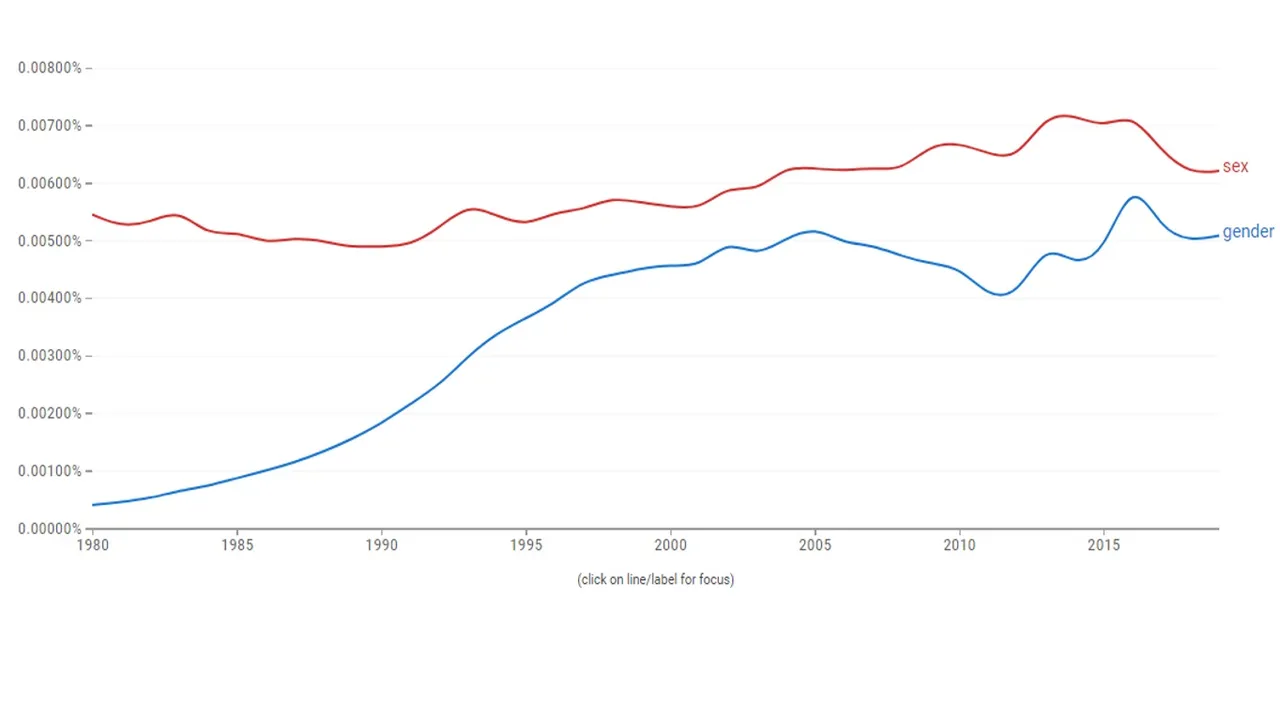
Source: Google Books
Figure 2: Frequency of Word/Phrase Usage of ‘Gender Identity’, ‘Gender Dysphoria’, ‘Transgender’ and ‘Cisgender’' and 'Gender' in Books
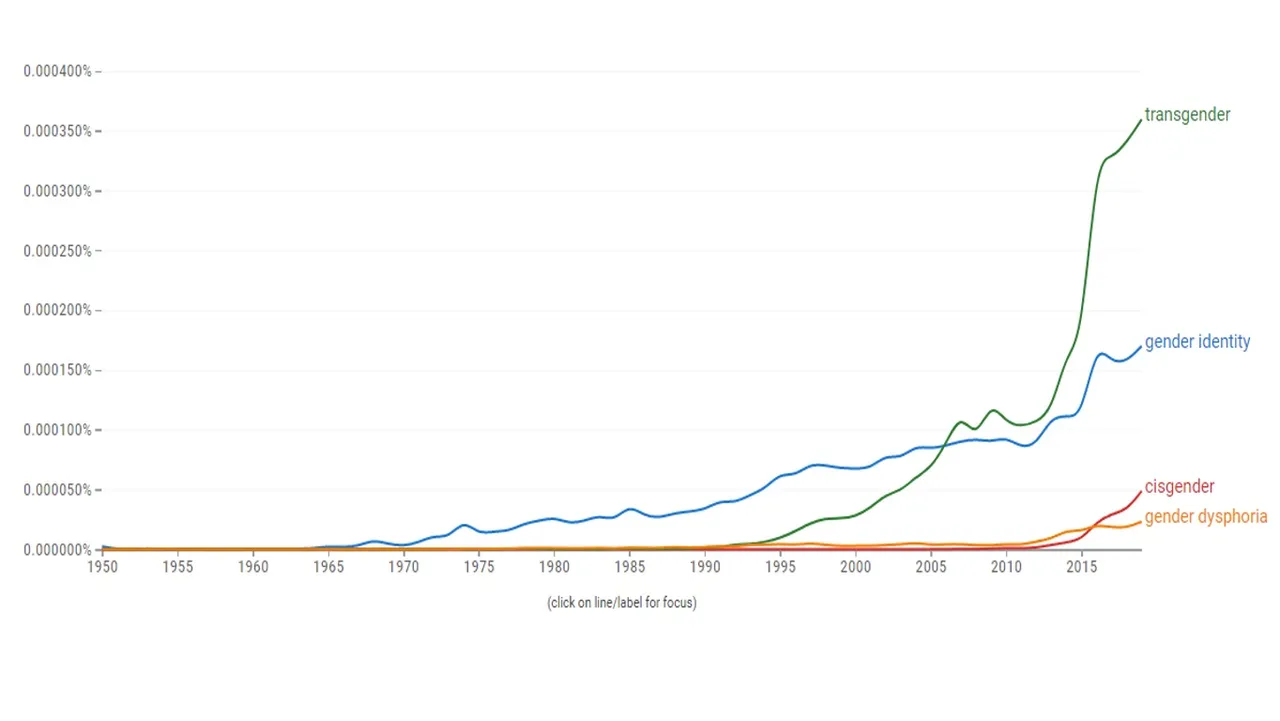
Source: Google Books
Figure 3: Google Search Trends for Words ‘Gender Identity’, ‘Transgender’ and ‘Cisgender’
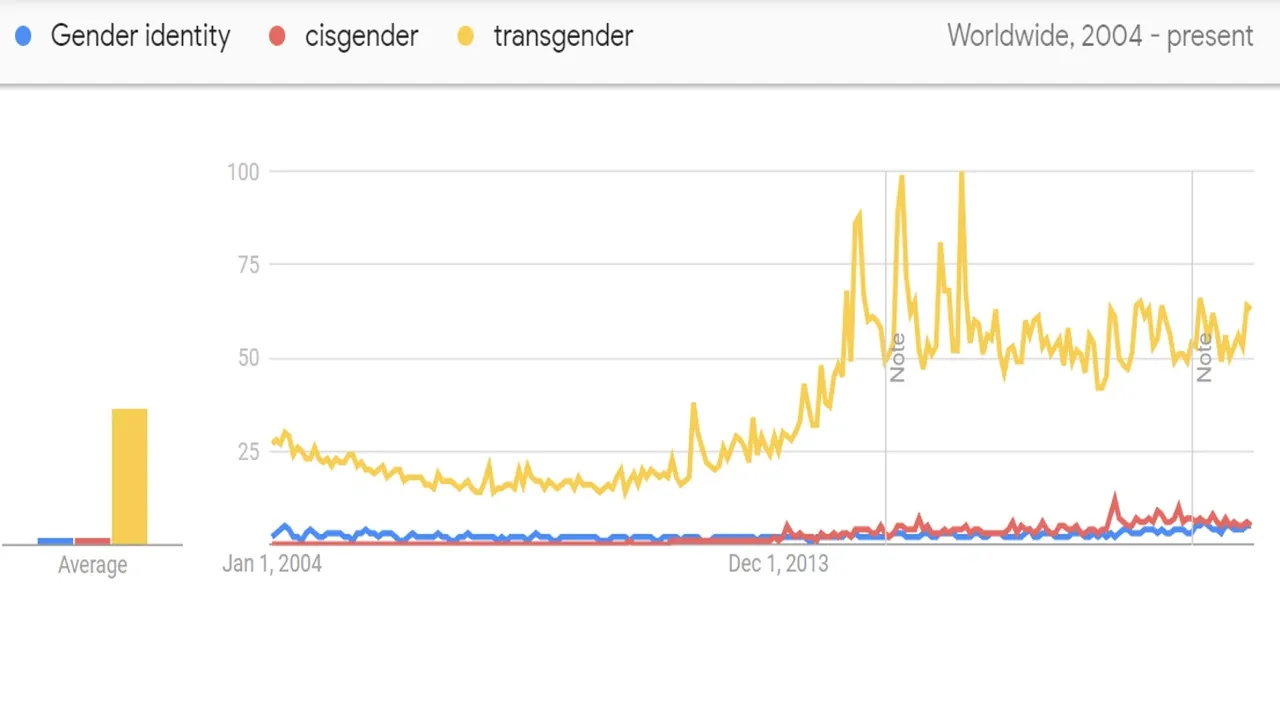
Source: Google Trends
The frequency of the usage of the word ‘transgender’ has increased rapidly over the past two decades. However, there is inconsistency in the definitions of this word. The dictionaries Merriam-Webster, dictionary.com, and Collins define ‘transgender’ as a conflict between ‘gender identity’ and ‘sex’. Dictionary.com adds a second definition that relates to a conflict between gender identity and gender. Whereas, the Cambridge Dictionary define ‘transgender’ as a term used to describe someone whose gender does not match the body they were born with (i.e. sex).
Definitions of Woman and Man
The definitions of 'woman' and 'man' relate to sex and not gender. Dictionaries do not provide a definition in the context of gender. They uniformly provide the same definitions for the words 'woman' and 'man'.
A woman is an adult female human being/person (Cambridge Dictionary, Collins Dictionary, dictionary.com, and Merriam-Webster)
A man is an adult male human being/person (Cambridge Dictionary, Collins Dictionary dictionary.com, and Merriam-Webster)
In the context of gender, they could have provided definitions such as ‘a man is a person perceived by society to be male based on his roles and behaviour’. In the context of gender identity, they could have provided definitions such as ‘a woman is a person who identifies as an adult female human being’. Instead, the definitions state that men and women are of a particular sex, men are male and women are female, plus qualifiers for age and species. See definitions of ‘sex’ that state that sexes are divided into two biological categories: ‘male; and ‘female’.
In the context of gender, based on the newer definition, we are comparing masculinity with femininity rather than male and female definitions. For example, a person’s sex could be male and his gender could be feminine. Since very few people follow their gender stereotype completely, a person’s gender might be 80% masculine and 20% feminine. Some might argue that gender is fluid. Therefore, a person might gradually become more masculine or feminine over time.
Some dictionaries confuse the topic further by adding ‘gender identity’ as an alternate meaning for ‘male' and ‘female’. For example, Merriam-Webster Dictionary, states that ‘male’ is having a gender identity that is the opposite of female. Most dictionaries focus on the biological definition.
Contradiction of the usage of the words gender and sex
According to dictionaries, the definitions of ‘sex’ and ‘gender’ have diverged. However, there contextual usage is confusing. For example, gender identity sometimes relates to sex and sometimes gender. Do the references to gender relate to the older definition of ‘sex’ or to the 'newer’ definition relating to social construct? Some dictionaries state gender dysphoria as a conflict between gender identity and sex and some state it as a conflict between gender identity and gender. This creates the impression that the words can be used interchangeably.
For the purpose of this post, to avoid confuse, I will use the word ‘sex’ to distinguish between ‘men’ and ‘women’. The word ‘gender’ is too subjective to be used to make useful comparisons. If the terminology ‘gender’ is used in data and statistics, I assume it has been used as an alternative to the word ‘sex’.
Feminism
Feminism is another key concept. It relates to the pursuit of improved quality of life for woman. Below are definitions of feminism from four different dictionaries.
Feminism is the doctrine advocating social, political, and all other rights of women equal to those of men (Dictionary.com)
Feminism is the belief that women should be allowed the same rights, power, and opportunities as men and be treated in the same way, or the set of activities intended to achieve this state (Cambridge Dictionay)
Feminism is the belief in and advocacy of the political, economic, and social equality of the sexes expressed especially through organized activity on behalf of women's rights and interests (Merriam-Webster Dictionary)
Feminism is the belief and aim that women should have the same rights, power, and opportunities as men (Collins Dictionary).
Based on my interpretations of the above definitions plus some of my own knowledge, I would argue the following:
- Feminism should advocate for human rights (same for both men and woman) rather than separate rights for women, which indicates a difference in the rights of men and women.
- Feminism should advocate for equal opportunities. This would relate to equal access to education, training, resources, and business opportunities. Job opportunities should be based on competence rather than sex.
- Feminism should advocate for equal recognition for work performed. Wage differentials should be based on ability and contribution and not differences in sex.
- Feminism should advocate for representative roles for women in governance. This would relate to decision-making and leadership in both the public and private sectors.
- Feminism should advocate for freedom (choice, speech, action, etc.). Women should be enabled to pursue the lives they desire without prejudice.
We also need to place context around what is meant be equality. Based on the definitions of ‘feminism’, I would argue that in the context of men and women, we should focus on equality in terms of treatment and opportunity.
Reducing Sex Inequality
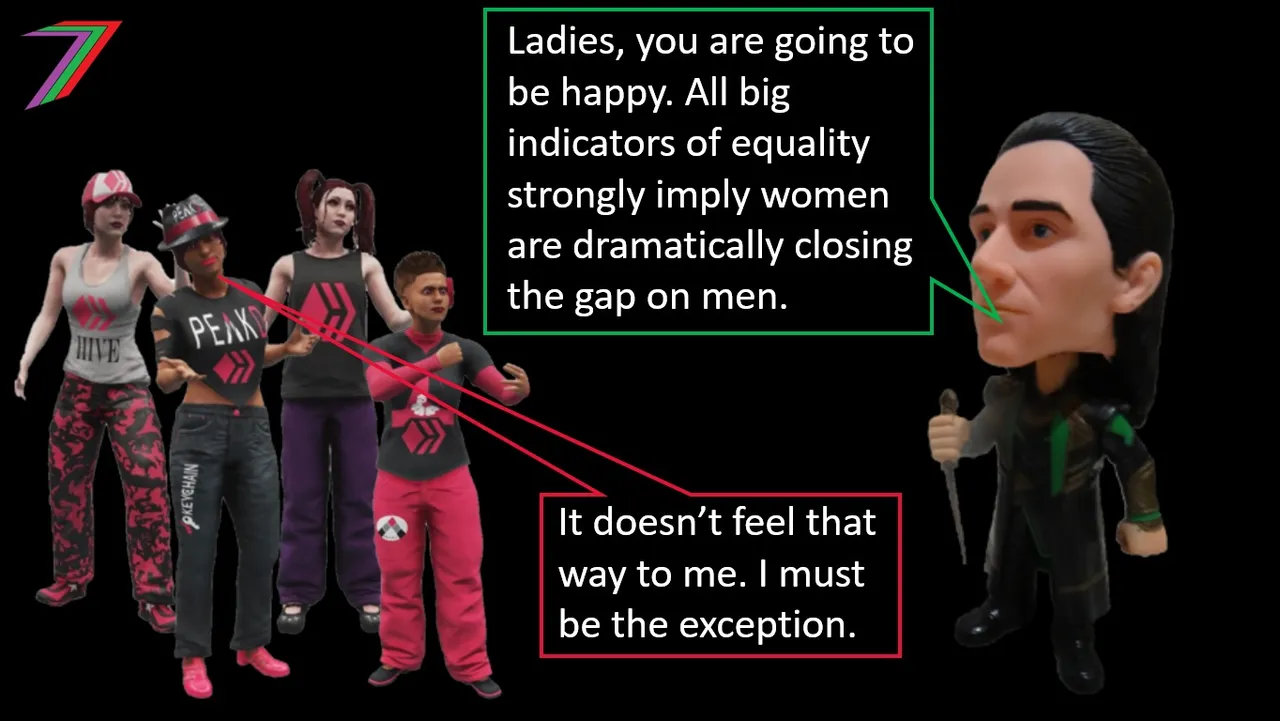
Has inequality between the sexes been reduced? According to many articles as well as several sex (referred to as gender) inequality indicators, inequality between men and women has narrowed. The indicators imply that North American and European countries are leading the way in reducing these inequalities.
In a 2020 article, Forbes provides ten examples of reduced inequality between men and women; some of these apply globally but many are focused on the US.
- Narrowed education gap around the world
- Inclusion in global agenda
- Greater representation in politics
- Women climbing higher in organisations
- Understanding of the pay gap between men and women
- Redefining masculinity in the context of men
- Improved voting rights for women
- Increased participation in the labour force
- Gender equity needed for AI development
- Equal Rights Amendment ratified by 38th State
Source: Forbes
The article is focused on a few areas. One of these areas is achieving higher economic growth from the inclusion of women in the workforce and in jobs that require a higher level of educational attainment (see points 1, 4, 5, 8, and 9). The article quotes statistics of how the educational attainment gaps in many countries have narrowed. Another area relates to inclusion and representation in global organisations, political parties and politics (see points 2, 3, 7, and 10). Employment in political parties makes up only a very small percentage of overall employment in a country. The inclusion of women in these jobs is a benefit to them but may not be representative of any benefits to women as a whole. It also assumes the women in political office intend to better represent women. The article briefly mentions redefining masculinity. It states that men desire to be more involved in raising their children during their early months. Desire does not necessary equate to reality (this is discussed later in the series with the support of data).
The United Nations (UN) Human Development Report compares gender (sex) inequality over time and between countries based on their criteria for inequality. They consider three main areas.
- Reproductive health (based on maternal mortality ratio and adolescent birth rates).
- Empowerment (based on proportion of parliamentary seats occupied by females and proportion of adult females aged 25 years and older with at least some secondary education).
- Economic status (based on labour market participation rates of female and male populations aged 15 years and older).
Source: United Nations cited by Our World in Data
Lower scores indicate greater sex equality. Figure 4 contains the index for regions of the world and Figure 5 contains the index for the top 18 countries based on their score in 2021.
Figure 4: Gender Inequality Index by Region (1990 to 2021)

Source: United Nations cited by Our World in Data
Figure 5: Gender Inequality index for best scoring countries (2021)
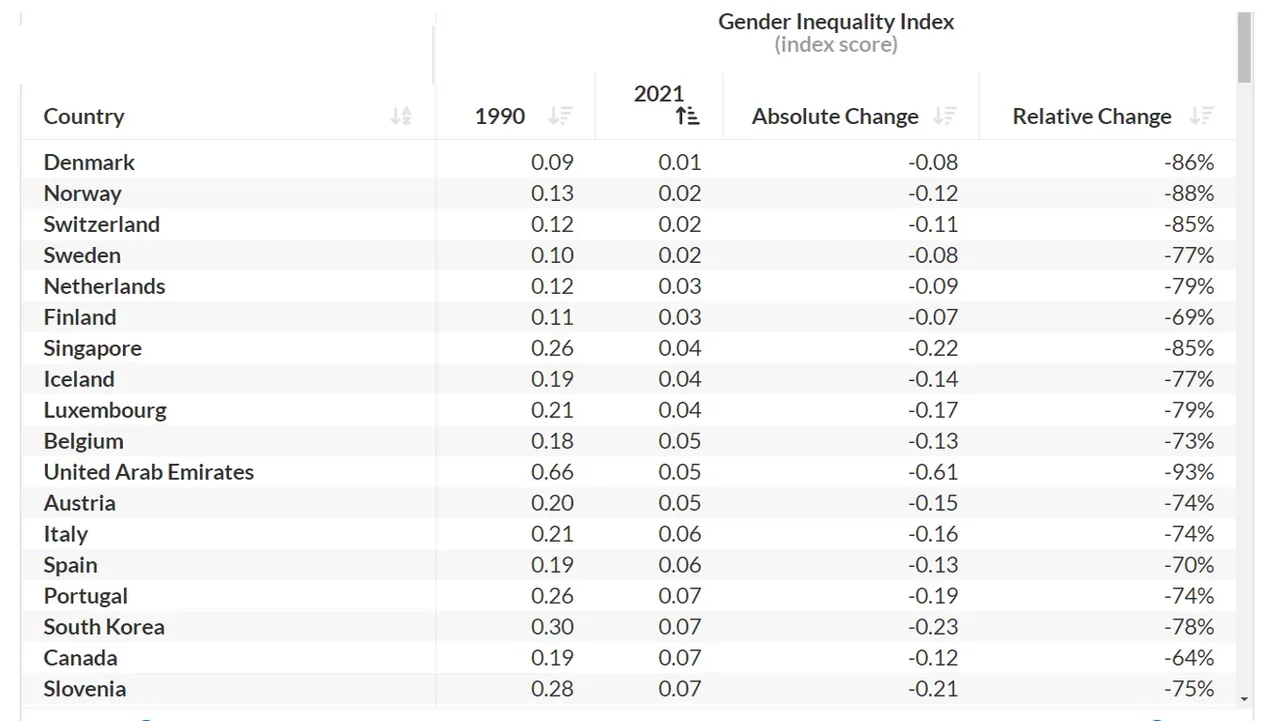
Source: United Nations cited by Our World in Data
Some of the criteria used to generate this index, have little or nothing to do with sex inequality. Reproductive health links more closely to the quality of a countries health system. Wealthier countries have better healthcare systems; therefore, will have a lower maternal mortality ratio. The number of parliamentary seats occupied by women can be easily manipulated. The major parties only need to select a higher percentage of women to run for their party; thus leading to more seats. As mentioned earlier, we can only assume that women in political office will represent women in general. Labour market participation is not a strong indicator of inequality. Culture and ideology affects the desire to participate in the labour market. Proportion of adult females with at least some secondary education may seem like a good indicator of sex inequality. However, when there is limited education available for females there is also limited education available for males. A better comparison for sex inequality is the female to male ratio for access to education. See Figure 6.
Figure 6: Gender Parity in Primary and Secondary Education (Data from 2010 to 2015)
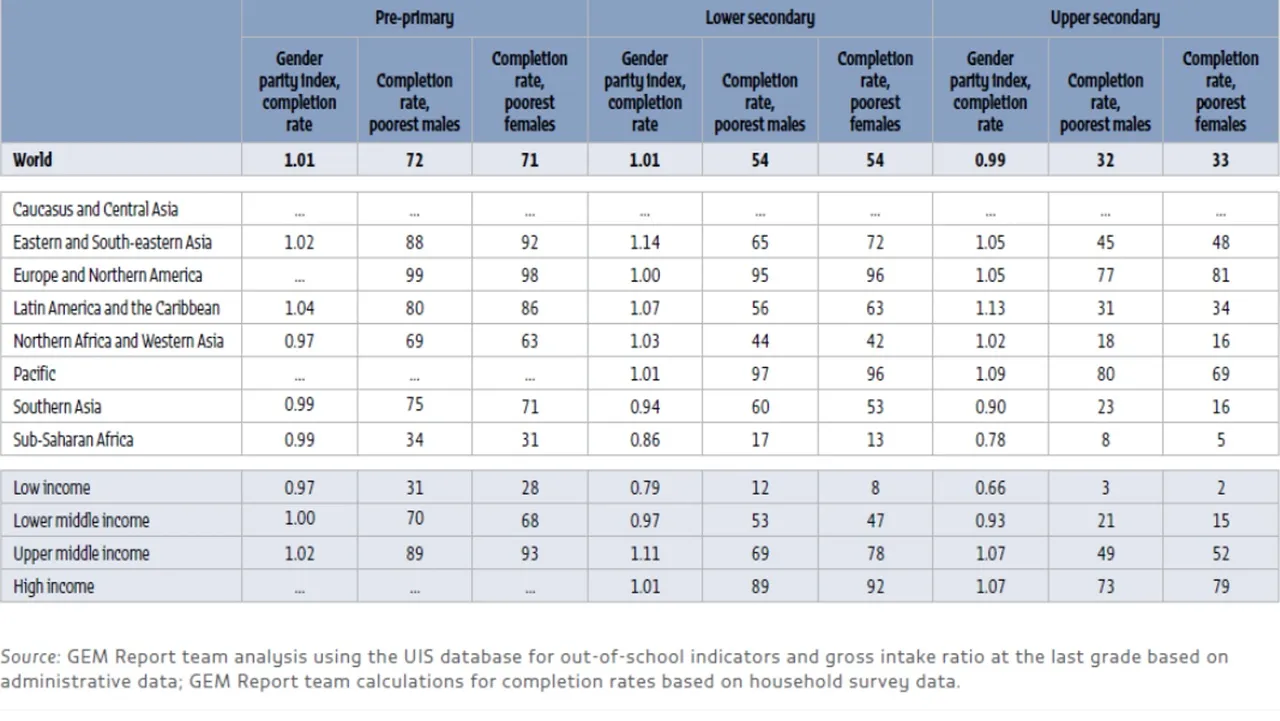
Source: Global Education Report
Figure 6 demonstrates that the overall availability of education is the main reason that women are able obtain a secondary education. It appears unrelated to inequality.
There are several other broad indicators of sex inequality such as the Gender-related Development Index (GDI), Gender Empowerment Measure (GEM), and Gender Gap Index (GGI). The World Economic Forum’s GGI appears the broadest in terms of inclusion of possible indicators and data.
GGI indicators include the following:
- Economic participation: male and female unemployment levels, levels of economic activity, and remuneration for equal work.
- Economic opportunity: duration of maternity leave, number of women in managerial positions, availability of government-provided childcare, wage inequalities between men and women.
- Political empowerment: number of female ministers, share of seats in parliament, women holding senior legislative and managerial positions, number of years a female has been head of state.
- Educational attainment: literacy rates, enrolment rates for primary, secondary and tertiary education, average years of schooling.
- Health and wellbeing: effectiveness of governments’ efforts to reduce poverty and inequality, adolescent fertility rate, percentage of births attended by skilled health staff, and maternal and infant mortality rates.
Source: OECD
The Gender Gap Index has many of the same problems as the Gender Inequality Index. It is heavily focused on aspects that link to wealth rather than comparisons between men and women. The Gender Gap Index has broader focus than the Gender Inequality Index. It includes percentage of women in managerial positions, wage inequalities between men and women, and remuneration for equal work. These inclusions are a small improvement. Managerial positions can be at any level in many organisations. A comparison of senior management positions would have been more useful. Wage inequalities are far less relevant if they are distorted by educational attainment. Instead, wages at the same educational attainment should have been compared. Remuneration for equal work is a good inclusion. Figure 7 contains the scores by region and subcategory.
Figure 7: Gender Gap Index scores by region
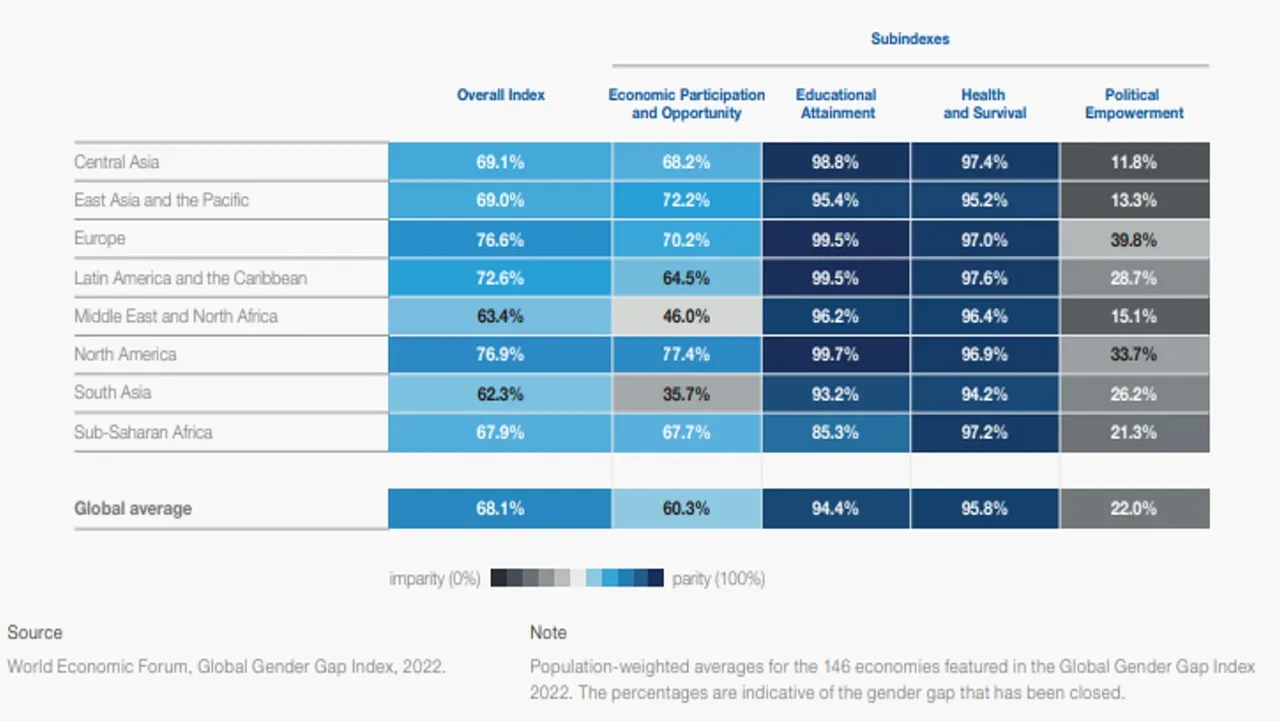
Source: World Economic Forum
The differences by region is much narrower for the Gender Gap Index than the Gender Inequality Index. This is because most countries have access to the most basic forms of education and healthcare. The differences in the scores between regions was very small. The widest variation related to political empowerment; thus, would have the most influence in determining a country’s and region’s index score. There was also some variance in the subcategories of economic participation and opportunity; thus, would also influence the index but to a lesser extent than political empowerment. Countries with a high percentage of women in the workforce and a high percentage of women in Government would score the highest on this index. Figure 8 contains the top twenty ranked countries by Gender Gap Index and the top twenty ranked countries by the political empowerment category.
Figure 8: Gender Gap Index and Political Empowerment Index scores by country

Source: World Economic Forum
The top three countries on both lists are the same (Iceland, Finland, and Norway). Out of the top 20 countries ranked on the Gender Gap Index, 16 were also ranked in the top 20 in the Political Empowerment Index. The exceptions were Lithuania, Moldova, Albania, and the Philippines. The results of the Gender Gap Index are very heavily skewed in favour of countries that have a high percentage of women in politicians. Gender equality statistics can be very easily manipulated. I discussed in my post, Raise your hand if you live in a Democracy, how politicians do not represent the people that vote for them. The same argument can be made about women politicians.
Quick Summary

Definitions and applications of the words ‘sex’, ‘gender’, and ‘gender identity’ are confusing and often contradictory. The application of the words should align with the definitions; in many cases they do not. This could be because the application of the words are lagging behind the changes in definitions (should not be the case as dictionaries claim changes to definitions are based on usage) and the rise in usage of new phrases. It could be because there is the intention to deceive people about the meaning and application of the words so as to split ‘conservative’ and ‘liberal’ opinions regarding usage. It could because changing the definitions of words such as 'man' and 'woman' was considered too political.
Sex (referred to as gender in the reports) inequality appears to be narrowing based on indicators provided by the United Nations and World Economic Forum. Western countries appear to be leading the way. However, upon further inspection of the composition of these indicators, it is apparent that they are measuring the benefits of increased wealth. In regards to the World economic Forum’s Gender Gap Index, the percentage of women holding political office is the key determinant of scores. Overall these indicators are sending a false message about the differences in sex inequality between countries and possibly even about the trends.
In Part 2, I briefly discuss the stereotyped differences between men and women. I follow this up by exploring differences that are supported by scientific research and data from Myers-Briggs Type Indicators (MBTI). This follows through to compare jobs predominantly held by women and the type of employer (Public Sector vs Private Sector). This leads to comparisons between the wages of men and women based on educational attainment. I also explore opportunities for top and senior management positions as well as business ownership. Part 2 finishes up with a comparison of women’s happiness to men’s and the changes over time.
More posts

If you want to read any of my other posts, you can click on the links below. These links will lead you to posts containing my collection of works. These 'Collection of Works' posts have been updated to contain links to the Hive versions of my posts.
Hive: Future of Social Media
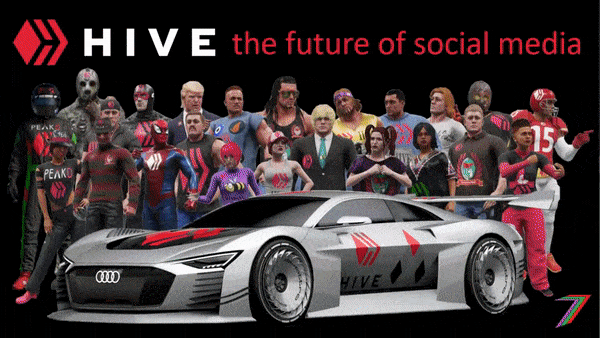
Spectrumecons on the Hive blockchain




